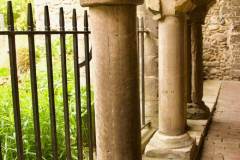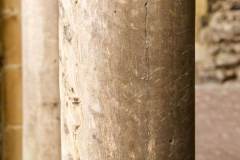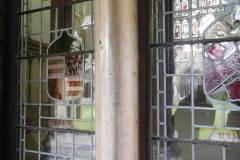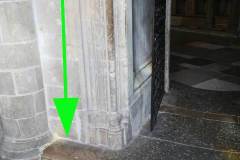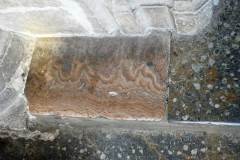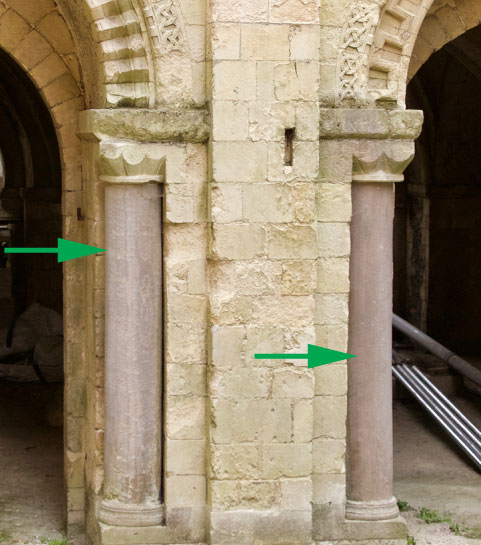
Basics
Geology: limestone precipitate
Rock unit: N/A
Age: Holocene
Provenance: The Eifel Region, western Germany – eastern Belgium
Where to see examples
Infirmary cloisters (images 1 and 2 below)
in the Chapter House windows (image 3 below)
columns in the former gateway beneath the Treasury (see image above)
entrance to St Anselm’ Chapel (images 4 and 5 below)
Description
A number of columns used at Canterbury Cathedral have been described, perhaps oxymoronically, as made of onyx marble. A geological marble is a limestone that has recrystallised under extremes of heat and pressure, whilst onyx is a banded stone made of silica (quartz). The stone described here as onyx marble is neither composed of silica nor it is a geological marble, but instead is made of calcium carbonate and best described as a limestone.
Columns of onyx marble can be seen in the former gateway below the Treasury on the north side of the cathedral. The gateway has been restored and cleaned so that the columns can be seen to display a delightful zig-zag pattern, evidence that the calcareous material was deposited in banded layers and further that the stone was laid end-bedded. Other examples of the stone’s use can be seen on the eastern side of the Infirmary Cloister and in the west windows of the Chapter House.
In the past this decorative stone has been described as a crystalline limestone deposited from solution at springs, or as a limestone formed in caves in a similar way to stalactites and stalagmites. Proposed sources for the stone have centred on the Mediterranean and ranged from North Africa to Italy to Turkey.
In Canterbury Cathedral Priory, in the Age of Becket by Peter Fergusson, Christopher Wilson describes the stone as calc-sinter (its German name): a limestone from the Eifel region to the west of the River Rhine. This deposit formed within the Roman aqueduct which traversed the Eifel uplands where long sections of the route took the aqueduct underground. Rainwater draining through a limestone landscape became saturated with calcium carbonate and, as a result of changes in pressure, temperature and/or chemical conditions, precipitation within the water channel laid down successive layers of lime (calcium carbonate), in a similar way, but much more slowly, as lime scale is deposited in a kettle in a hard water area. The build up of limestone can be seen as a crenulated or wavy line which formed parallel to the flow of water.
In the Middle Ages this build up of calcium carbonate within the aqueduct was exploited as a decorative building material. At some point during the twelfth century calc-sinter blocks were transported to Kent probably following a route down the River Rhine and across the English Channel. The material is known to have been used as a decorative stone at Canterbury Cathedral, St Augustine’s Abbey and Rochester Cathedral. Similar stones do occur, in limited quantities, throughout the Mediterranean region and while the stones could be from another source, it is known that the Eifel Roman aqueduct was being quarried in the twelfth century and this remains the closest potential source for the stone with a practical transportation route to Canterbury.

